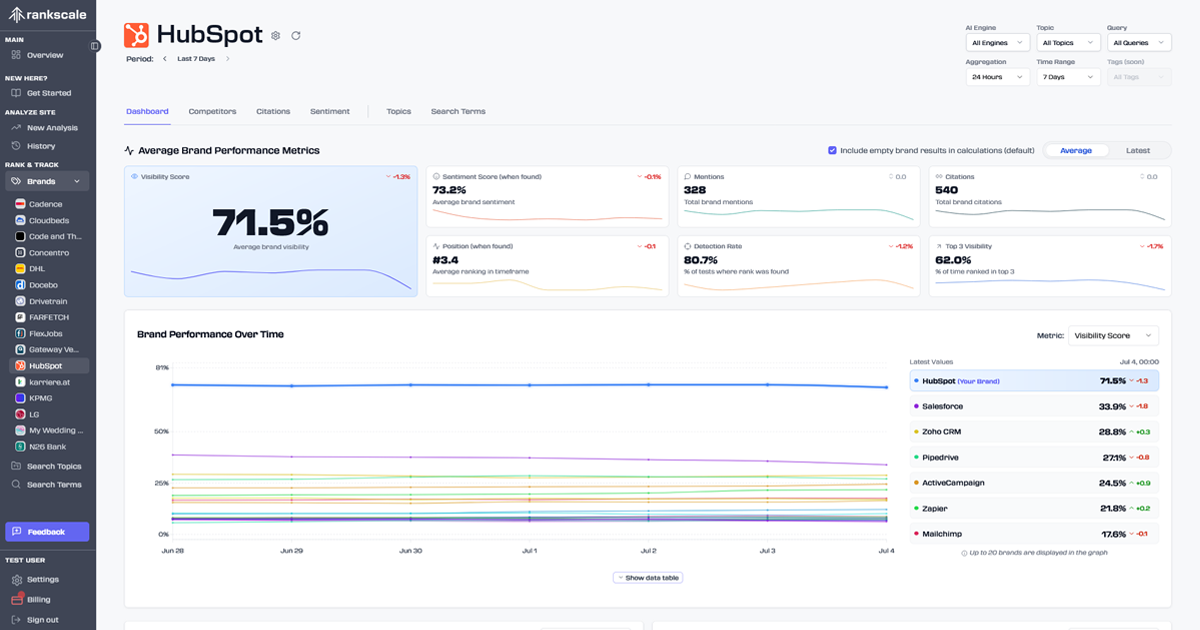Clear Dashboards
Here’s a breakdown of the key metrics Rankscale tracks, what they actually mean, and why they matter to you.
The Key Metrics Behind a Successful GEO Program
Generative Engine Optimization (GEO) is new territory for most marketing leaders. Unlike traditional SEO, where metrics like rankings and backlinks dominate, GEO is about visibility in AI-powered conversations. That’s why we use Rankscale for standardized reporting. They measure how often, how positively, and how credibly your brand is showing up in AI-generated answers.

Here’s a breakdown of the key metrics Rankscale tracks, what they actually mean, and why they matter to you.
1. Visibility Score
What it is: A measure of how frequently your brand appears in generative answers across your defined prompt universe.
Why it matters: Visibility is the first step in influence. If your brand isn’t showing up in AI answers, it’s effectively invisible to decision-makers relying on generative search.
How we use it: We benchmark your visibility score against competitors to reveal gaps and opportunities.
2. Sentiment
What it is: The tone or perception of your brand in AI-generated answers positive, neutral, or negative.
Why it matters: It’s not enough to appear; you need to appear in the right light. Negative sentiment can quickly erode trust.
How we use it: We surface patterns where AI engines are associating your brand with risk, confusion, or weak comparisons — then develop content and positioning to shift that narrative.
3. Mentions
What it is: The raw count of times your brand is cited across AI-generated answers.
Why it matters: Mentions show presence, but also serve as a proxy for authority. A brand consistently mentioned across multiple answers builds trust with both engines and users.
How we use it: We track not just the volume of mentions, but the context... are you mentioned as a leader, an alternative, or an afterthought?
4. Citations
What it is: The number of times your brand’s content (pages, articles, case studies, etc.) is directly referenced as a source in AI-generated answers.
Why it matters: Citations are the currency of credibility in GEO. They show that your content isn’t just present it’s trusted enough to be pulled directly into AI responses.
How we use it: We analyze which content assets are earning citations and replicate those patterns across other topics in your prompt universe.
5. Average Position
What it is: Your relative ranking when AI engines present lists or comparative answers (e.g., “Top 5 X tools”).
Why it matters: Position determines click-through and perceived authority. Being “#3 alternative” vs. “#1 recommended” changes how buyers view your brand.
How we use it: We monitor shifts in position across key prompts to measure whether optimization efforts are moving you up the ladder.
6. Detection Rate
What it is: The percentage of prompts where Rankscale successfully detects your brand in AI-generated outputs.
Why it matters: A higher detection rate means your brand is consistently recognized by AI systems — critical for building durable visibility.
How we use it: We use detection rate to spot blind spots in your prompt universe. If you’re missing from a cluster of prompts where competitors are present, that’s a signal for content expansion.
What These Metrics Mean for You
Individually, these metrics give you slices of performance. Together, they tell a story about:
- Where your brand shows up (visibility, mentions).
- How your brand is perceived (sentiment, citations).
- Whether you’re winning vs. competitors (average position, detection rate).
This gives you a clear, quantifiable view of your GEO strategy, replacing guesswork with data-backed priorities.
.png)


